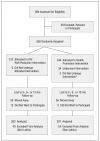A randomized controlled trial testing an HIV prevention intervention for Latino youth
- PMID: 16894074
- PMCID: PMC3034476
- DOI: 10.1001/archpedi.160.8.772
A randomized controlled trial testing an HIV prevention intervention for Latino youth
Erratum in
- Arch Pediatr Adolesc Med. 2006 Nov;160(11):1187
Abstract
Objective: To test the efficacy of a prevention intervention to reduce sexual risk behavior among Latino adolescents.
Design: Randomized controlled trial from April 2000 through March 2003, with data collection before and after intervention and at 3, 6, and 12 months.
Setting: Northeast Philadelphia schools.
Participants: Latinos aged 13 through 18 years (249 males and 304 females); 81.6% retained at 12-month follow-up.
Interventions: The HIV and health-promotion control interventions consisted of six 50-minute modules delivered by adult facilitators to small, mixed-gender groups in English or Spanish. Main Outcome Measure Self-reported sexual behavior.
Results: Analyses using generalized estimation equations over the follow-up period revealed that adolescents in the HIV intervention were less likely to report sexual intercourse (odds ratio, 0.66; 95% confidence interval [CI], 0.46-0.96), multiple partners (odds ratio, 0.53; 95% CI, 0.31-0.90), and days of unprotected intercourse (relative risk, 0.47; 95% CI, 0.26-0.84) and more likely to report using condoms consistently (odds ratio, 1.91; 95% CI, 1.24-2.93). Baseline sexual experience and language use moderated intervention efficacy. Adolescents assigned to the HIV intervention who were sexually inexperienced at baseline reported fewer days of unprotected sex (relative risk, 0.22; 95% CI, 0.08-0.63); Spanish speakers were more likely to have used a condom at last intercourse (odds ratio, 4.73; 95% CI, 1.72-12.97) and had a greater proportion of protected sex (mean difference, 0.35; P<.01) compared with similar adolescents in the health-promotion intervention.
Conclusion: Results provide evidence for the efficacy of HIV intervention in decreasing sexual activity and increasing condom use among Latino adolescents.
Figures




References
-
- Centers for Disease Control and Prevention (CDC) Diagnosis of HIV/AIDS—32 states, 2000-2003. MMWR Morb Mortal Wkly Rep. 2004;53:1106–1110. - PubMed
-
- Centers for Disease Control and Prevention. National Center for HIV, STD and TB Prevention, Divisions of HIV/AIDS Prevention HIV/AIDS among Hispanics. [Accessed February 10, 2005]. http://www.cdc.gov/hiv/pubs/facts/hispanic.htm.
-
- Rosenberg PS, Biggar RJ. Trends in HIV incidence among young adults in the United States. JAMA. 1998;279:1894–1899. - PubMed
-
- Grunbaum JA, Kann L, Kinchen S, et al. Youth risk behavior surveillance—United States, 2003. MMWR Surveill Summ. 2004;53:1–96. published corrections appear in MMWR Morb Mortal Wkly Rep. 2004;53:536; MMWR Morb Mortal Wkly Rep. 2005;54:608. - PubMed
-
- Centers for Disease Control and Prevention (CDC) Trends in sexual risk behaviors among high school students—United States, 1991-2001. MMWR Morb Mortal Wkly Rep. 2002;51:856–859. - PubMed
Publication types
MeSH terms
Grants and funding
LinkOut - more resources
Full Text Sources
Medical
Miscellaneous

